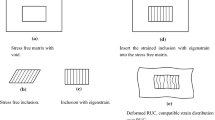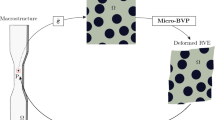Abstract
As a reduced order homogenization approach, the FEM-Cluster based reduced order Analysis method (FCA) proposed by Cheng et al. provides an efficient approach to predict the nonlinear effective properties of heterogeneous materials. In its improved version, the clustered Minimum Complementary Energy (MCE) approach is adopted for the computations of incremental strain–stress relation. This work mainly focuses on the mathematical foundations of FCA with clustered MCE. The completeness of the interaction matrix as the clustered self-equilibrium stress space is proved, and the prediction error of FCA solution is analyzed. The deductions also reveal that some bases of the clustered self-equilibrium stress space denoted by the interaction matrix may contradict the basic hypothesis of the cluster-based reduce order methods, and they are mainly responsible for the error of FCA. According to this observation, a spectral analysis algorithm is developed to refine the interaction matrix and improve the accuracy of FCA.







Similar content being viewed by others
Abbreviations
- \({0}_{m}\in {\mathbb{R}}^{m}\) :
-
\(m\)-order vector with all elements equaling zero
- \({I}_{m}\in {\mathbb{R}}^{m\times m}\) :
-
\(m\)-order identity matrix
- \(rank\left(a\right)\) :
-
Rank of the matrix a
- \(dim\) :
-
Dimension of the problem
- \(d\) :
-
Number of degree of freedom in strain or stress
- \(N\) :
-
Number of clusters
- \(n\) :
-
Number of elements in the finite element model
- \({e}_{i}\in {\mathbb{R}}^{d}\) :
-
Unit orthogonal vector
- \(\Omega \subset {\mathbb{R}}^{dim}\) :
-
Domain of the representative unit cell
- \({\Omega }_{I}\subset\Omega \) :
-
Domain of the Ith cluster
- \(\left|\Omega \right|\) :
-
Volume of Ω
- \(\left|{\Omega }_{I}\right|\) :
-
Volume of Ωl
- \({\chi }_{I}\left(x\right)\) :
-
Characteristic functions of Ωl, see (5)
- \(\varepsilon \left(x\right):\Omega \to {\mathbb{R}}^{d}\) :
-
Strain
- \({\varepsilon }^{mech}\left(x\right):\Omega \to {\mathbb{R}}^{d}\) :
-
Mechanical strain
- \({\varepsilon }^{0}\in {\mathbb{R}}^{d}\) :
-
Uniform loaded eigenstrain
- \(\sigma \left(x\right):\Omega \to {\mathbb{R}}^{d}\) :
-
Stress
- \({\tilde{\sigma }}_{I}\in {\mathbb{R}}^{d}\) :
-
Average of σ in Ωl, see (7)
- \(\overline{Q }\) :
-
Cluster-average operator, see (6)
- \(\widehat{Q}\) :
-
Cluster-approximation operator, see (18)
- \(\overline{A }\) :
-
Cluster-average of A whose columns are stress, see (15)
- \(\widehat{A}\) :
-
Cluster-approximation of \(A\) whose columns are stress, see (12)
- \(\langle \cdot \rangle \) :
-
Integration over Ω that \( \left\langle {a\left( x \right)} \right\rangle = \mathop \smallint \limits_{{x \in \Omega }}^{{}} a\left( x \right)dx \)
- \(span\left(A\right)\) :
-
Space spanned by the columns of A
- \({\mathbb{E}}\) :
-
Complete self-equilibrium stress set
- \(\Sigma \) :
-
Generalized orthogonal complete self-equilibrium stress set
- \({\Sigma }_{i}\left(x\right):\Omega \to {\mathbb{R}}^{d}\) :
-
Stress bases (columns) of Σ, see (21)
- \({\lambda }_{i}\) :
-
Eigenvalues in spectral analysis algorithm, see (21)
- \(S\left(x\right):\Omega \to Sym(d)\) :
-
Inverse of algorithmic tangent moduli
- \({S}^{E}\in Sym(d)\) :
-
Material compliance in linear elastic stage
- \({\mathbb{S}}\left(x\right):\Omega \to Sym(d)\) :
-
Unique inverse of algorithmic tangent moduli, see (36)
- \(\overline{S }\in Sym(Nd)\) :
-
Block diagonal matrix of inverse of algorithmic tangent moduli in all clusters, see (12)
- \(\overline{V }\in Sym(Nd)\) :
-
Block diagonal matrix of clusters’ volume, see (12)
- \(\mathcal{A}\) :
-
Strain-concentration factors
- \(D\) :
-
Interaction matrix, see (13)
- \({D}^{*}\) :
-
Interaction matrix obtained with spectral analysis algorithm, see (54)
- \({\mathbb{E}}^{D}\) :
-
Self-equilibrium stress set for creating D
- \({\mathbb{E}}_{I,i}^{D}\left(x\right):\Omega \to {\mathbb{R}}^{d}\) :
-
Columns of \({\mathbb{E}}^{D}{\mathbb{E}}^{D}\)
- \({\varepsilon }_{I,i}^{0}\left(x\right):\Omega \to {\mathbb{R}}^{d}\) :
-
Eigenstrain for obtaining \({\mathbb{E}}_{{I,i}}^{D}{\mathbb{E}}_{{I,i}}^{D}\)
- \({\Vert \cdot \Vert }_{S}\) :
-
Distance metric for stress, see (24)
- \(\Delta {\sigma }_{DNS}\left(x\right):\Omega \to {\mathbb{R}}^{d}\) :
-
Stress solution of DNS approach
- \(\Delta {\widehat{\sigma }}_{FCA}\left(x\right):\Omega \to {\mathbb{R}}^{d}\) :
-
Stress solution of FCA approach with D
- \(\Delta {\widehat{\sigma }}_{FCA}^{*}\left(x\right):\Omega \to {\mathbb{R}}^{d}\) :
-
Stress solution of FCA approach with D
References
Eshelby JD (1957) The determination of the elastic field of an ellipsoidal inclusion, and related problems. Proc R Soc Lond 241:376–396
Hill R (1965) A self-consistent mechanics of composite materials. J Mech Phys Solids 13:213–222
Christensen RM, Lo KH (1979) Solutions for effective shear properties in three phase sphere and cylinder models. J Mech Phys Solids 27:315–330
Benveniste Y (1987) A new approach to the application of Mori-Tanaka’s theory in composite materials. Mech Mater 6:147–157
Mori T, Tanaka K (1973) Average stress in matrix and average elastic energy of materials with misfitting inclusions. Acta Metall 21:571–574
Voigt AW (1889) Über die Beziehung zwischen den beiden Elastizitätskonstanten isotroper Körper. Wied Ann 38:573–587
Reuss A (1929) Berechnung der Fließgrenze von Mischkristallen auf Grund der Plastizitätsbedingung für Einkristalle. Z angew Math Mech 9:49–58
Hashin Z, Shtrikman S (1962) A variational approach to the theory of the elastic behaviour of polycrystals. J Mech Phys Solids 10:343–352
Bensoussan A, Lions J-L, Papanicolaou G (1991) Asymptotic analysis for periodic structures. Am Math Soc Encyclopedia Math Appl 20:307–309
Hao P, Wang B, Li G et al (2014) Hybrid optimization of hierarchical stiffened shells based on smeared stiffener method and finite element method. Thin-Walled Struct 82:46–54
Moulinec H, Suquet P (1998) A numerical method for computing the overall response of nonlinear composites with complex microstructure. Comput Methods Appl Mech Eng 157:69–94
Müller V, Kabel M, Andrä H, Böhlke T (2015) Homogenization of linear elastic properties of short-fiber reinforced composites—a comparison of mean field and voxel-based methods. Int J Solids Struct 67–68:56–70
Wang B, Fang G, Liu S, Fu M, Liang J (2018) Progressive damage analysis of 3D braided composites using FFT-based method. Compos Struct 192:255–263
Schneider M (2021) A review of non-linear FFT-based computational homogenization methods. Acta Mech 232:2051–2100
Brisard S (2017) Reconstructing displacements from the solution to the periodic Lippmann-Schwinger equation discretized on a uniform grid. Int J Numer Methods Eng 109(4):459–486
Zeman J, de Geus TWJ, Vondřejc J, Peerlings RHJ, Geers MGD (2017) A finite element perspective on nonlinear FFT-based micromechanical simulations. Int J Numer Methods Eng 111(10):903–926
Brisard S, Dormieux L (2010) FFT-based methods for the mechanics of composites: A general variational framework. Comput Mater Sci 49(3):663–671
Brisard S, Dormieux L (2012) Combining Galerkin approximation techniques with the principle of Hashin and Shtrikman to derive a new FFT-based numerical method for the homogenization of composites. Comput Methods Appl Mech Eng 217–220:197–212
Feyel F (2003) A multilevel finite element method (FE2) to describe the response of highly non-linear structures using generalized continua. Comput Methods Appl Mech Eng 192(28–30):3233–3244
Matsui K, Terada K, Yuge K (2004) Two-scale finite element analysis of heterogeneous solids with periodic microstructures. Comput Struct 82:593–606
Terada K, Kato J, Hirayama N, Inugai T, Yamamoto K (2013) A method of two-scale analysis with micro-macro decoupling scheme: application to hyperelastic composite materials. Comput Mech 52(5):1199–1219
Spahn J, Andrä H, Kabel M, Müller R (2014) A multiscale approach for modeling progressive damage of composite materials using fast Fourier transforms. Compu Methods Appl Mech Eng 268:871–883
Canova G, Wenk H, Molinari A (1992) Deformation modelling of multi-phase polycrystals: case of a quartz-mica aggregate. Acta Metall Mater 40(7):1519–1530
Dvorak GJ (1992) Transformation field analysis of inelastic composite materials. Proc R Soc Lond A 437:311–327
Michel JC, Suquet P (2003) Nonuniform transformation field analysis. Int J Solids Struct 40:6937–6955
Roussette S, Michel J-C, Suquet P (2009) Nonuniform transformation field analysis of elastic–viscoplastic composites. Compos Sci Technol 69:22–27
Berkooz G, Holmes P, Lumley JL (1993) The proper orthogonal decomposition in the analysis of turbulent flows. Annu Rev Fluid Mech 25:539–575
Yvonnet J, He QC (2007) The reduced model multiscale method (R3M) for the non-linear homogenization of hyperelastic media at finite strains. J Comput Phys 223(1):341–368
Goury O, Amsallem D, Bordas SPA, Liu WK, Kerfriden P (2016) Automatised selection of load paths to construct reduced-order models in computational damage micromechanics: from dissipation-driven random selection to Bayesian optimization. Comput Mech 58(2):213–234
Néron D, Boucard P-A, Relun N (2015) Time-space PGD for the rapid solution of 3D nonlinear parametrized problems in the many-query context. Int J Numer Methods Eng 103:275–292
Liu Z, Bessa M, Liu WK (2016) Self-consistent clustering analysis: an efficient multi-scale scheme for inelastic heterogeneous materials. Comput Methods Appl Mech Eng 306:319–341
Liu Z, Fleming M, Liu WK (2018) Microstructural material database for self-consistent clustering analysis of elastoplastic strain softening materials. Comput Methods Appl Mech Eng 330:547–577
Li H, Kafka OL, Gao J, Cheng Yu, Nie Y, Zhang L, Tajdari M, Shan Tang X, Guo GL et al (2019) Clustering discretization methods for generation of material performance databases in machine learning and design optimization. Comput Mech 64(2):281–305
Tang S, Zhang L, Liu WK (2018) From virtual clustering analysis to self-consistent clustering analysis: a mathematical study. Comput Mech 62:1443–1460
Zhu X, Zhang L, Tang S (2021) Adaptive selection of reference stiffness in virtual clustering analysis. Comput Methods Appl Mech Eng 376:113621
Zhang L, Tang S, Yu C, Zhu X, Liu WK (2019) Fast calculation of interaction tensors in clustering-based homogenization. Comput Mech 64:351–364
Wulfinghoff S, Cavaliere F, Reese S (2018) Model order reduction of nonlinear homogenization problems using a hashin-shtrikman type finite element method. Comput Methods Appl Mech Eng 330:149–179
Cavaliere F, Reese S, Wulfinghoff S (2019) Efficient two-scale simulations of engineering structures using the Hashin-Shtrikman type finite element method. Comput Mech 65:159–175
Schneider M (2019) On the mathematical foundations of the self-consistent clustering analysis for non-linear materials at small strains. Comput Methods Appl Mech Eng 354:783–801
Cheng GD, Li XK, Nie YH, Li HY (2019) FEM-Cluster based reduction method for efficient numerical prediction of effective properties of heterogeneous material in nonlinear range. Comput Methods Appl Mech Eng 348:157–184
Nie YH, Cheng GD, Li XK, Xu L, Li K (2019) Principle of cluster minimum complementary energy of FEM-cluster-based reduced order method: fast updating the interaction matrix and predicting effective nonlinear properties of heterogeneous material. Comput Mech 64:323–349
Nie YH, Li Z, Cheng GD (2021) Efficient prediction of the effective nonlinear properties of porous material by FEM-Cluster based Analysis (FCA). Comput Methods Appl Mech Eng 383:113921
Simo JC, Hughes TJR (2006) Computational inelasticity. Springer Science & Business Media, Berlin
Matsaglia G, Styan GPH (1974) Equalities and inequalities for ranks of matrices. Linear Multilinear Algebra 2:269–292
Yan J, Hu WB, Duan ZY (2015) Structure/material concrrent optimization of lattice materials based on extended multiscale finite element method. J Multiscale Comput Eng 13:73–90
Acknowledgements
The present work was supported by the National Natural Science Foundation of China (Grant Nos. 11602050, 11702053 and 11821202), the 111 Project (Grant No. B14013), and the Fundamental Research Funds for the Central Universities (Grant No. DUT2019TD37).
Author information
Authors and Affiliations
Corresponding author
Additional information
Publisher's Note
Springer Nature remains neutral with regard to jurisdictional claims in published maps and institutional affiliations.
Rights and permissions
About this article
Cite this article
Li, Z., Nie, Y. & Cheng, G. Mathematical foundations of FEM-cluster based reduced order analysis method and a spectral analysis algorithm for improving the accuracy. Comput Mech 69, 1347–1363 (2022). https://doi.org/10.1007/s00466-022-02144-3
Received:
Accepted:
Published:
Issue Date:
DOI: https://doi.org/10.1007/s00466-022-02144-3




